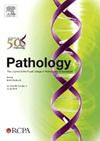p53 immunohistochemistry staining is a rapid screening method for TP53 mutation in myeloid malignancies suitable for integration into routine diagnostic laboratory practice
IF 3
3区 医学
Q1 PATHOLOGY
引用次数: 0
Abstract
TP53 mutations are a recognised poor prognostic marker across myeloid malignancies associated with inferior overall survival. Immunohistochemistry (IHC) for p53 represents a promising adjunctive test with rapid turn-around; however, controversy exists around its utility and optimal positive staining threshold. The aims of this study were to determine the diagnostic testing characteristics and optimal threshold of positive staining for p53 IHC in comparison to next-generation sequencing (NGS) results across myeloid malignancies and compare haematopathologist review to digital analysis. A total of 117 bone marrow samples, including TP53 wild-type (n=50) and TP53 mutant (n=67) based on NGS results, were independently assessed by two blinded haematopathologists and analysed using image analysis software with reliability assessment. A receiver operating characteristic curve was used to determine the optimal cut-off for predicting TP53 mutation. There was high reliability between reviewers [intraclass correlation (ICC) 0.84; confidence interval (CI) 0.783–0.891] and between average reviewer and analysis software (ICC 0.794; CI 0.715–0.853). The area under the curve was similar (p=0.818) for computer versus average reviewer. The optimal cut-off for reviewer assessment was 2% strong positive staining with adequate sensitivity (70%) and specificity (90%). p53 IHC has adequate test characteristics to be considered as a rapid screen to identify cases of TP53 mutation. Issues remain in identifying truncating and some splicing mutations.
p53免疫组织化学染色是一种快速筛查髓系恶性肿瘤TP53突变的方法,适合纳入常规诊断实验室实践。
TP53突变是公认的髓系恶性肿瘤预后不良的标志物,与总生存率较低相关。免疫组织化学(IHC)检测p53是一种很有前途的辅助检测方法。然而,围绕其效用和最佳阳性染色阈值存在争议。本研究的目的是确定p53 IHC的诊断测试特征和阳性染色的最佳阈值,并将其与下一代测序(NGS)结果进行比较,并将血液病理学家的评论与数字分析进行比较。共有117份骨髓样本,根据NGS结果,包括TP53野生型(n=50)和TP53突变型(n=67),由两名盲法血液病理学家独立评估,并使用图像分析软件进行可靠性评估。使用受体工作特征曲线来确定预测TP53突变的最佳截止值。审稿人之间的信度较高[类内相关系数(ICC) 0.84;置信区间(CI) 0.783-0.891],平均审稿人与分析软件之间(ICC 0.794;可信区间0.715 - -0.853)。计算机审稿人和普通审稿人的曲线下面积相似(p=0.818)。审稿人评估的最佳截止值为2%强阳性染色,具有足够的灵敏度(70%)和特异性(90%)。IHC具有足够的检测特征,可作为快速筛选TP53突变病例的方法。问题仍然是确定截断和一些剪接突变。
本文章由计算机程序翻译,如有差异,请以英文原文为准。
求助全文
约1分钟内获得全文
求助全文
来源期刊

Pathology
医学-病理学
CiteScore
6.50
自引率
2.20%
发文量
459
审稿时长
54 days
期刊介绍:
Published by Elsevier from 2016
Pathology is the official journal of the Royal College of Pathologists of Australasia (RCPA). It is committed to publishing peer-reviewed, original articles related to the science of pathology in its broadest sense, including anatomical pathology, chemical pathology and biochemistry, cytopathology, experimental pathology, forensic pathology and morbid anatomy, genetics, haematology, immunology and immunopathology, microbiology and molecular pathology.
 求助内容:
求助内容: 应助结果提醒方式:
应助结果提醒方式:


